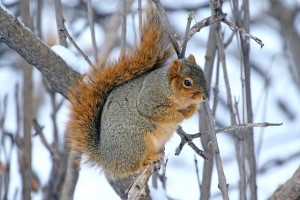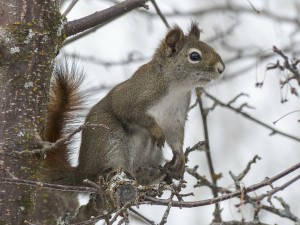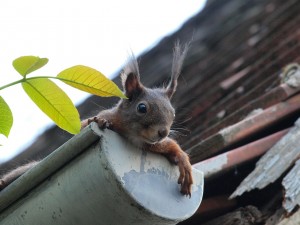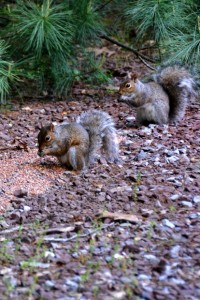 The name “squirrel” comes from the Greek word skiouros, which means shade tail (the most obvious trait of a squirrel). The squirrel family is quite large and includes chipmunks, prairie dogs, and marmots, but to most people “squirrel” refers to the 122 species of tree squirrels.
The name “squirrel” comes from the Greek word skiouros, which means shade tail (the most obvious trait of a squirrel). The squirrel family is quite large and includes chipmunks, prairie dogs, and marmots, but to most people “squirrel” refers to the 122 species of tree squirrels.
Squirrels have long, thin bodies, and long bushy tails. They have furred feet and their forefeet have four digits and a thumb while their hind feet are narrow with five toes. They also have large sharp, curved claws, which helps them run up and down trees.
Tree squirrels have sharp teeth and strong jaws that they use to eat hard nuts and fruits along with seeds, insects, and sometimes even bird eggs. Their jaws and teeth are also helpful in making their nests out of branches, vines, and undergrowth.
While tree squirrels look small and cute, they can certainly do some damage if they get into your home. Thanks to their teeth and claws, this damage can be costly and extensive.
Local tree squirrels are considered pests. These squirrels can find ways to enter attics in the winter and if they do not have their acorns or trees to trim their teeth on, they may start gnawing on the wood inside your home. In addition to sharpening their teeth on wood, squirrels may chew through cables, electrical, and telephone cables in an attempt to build a nest indoors. This damage can become an expensive financial disaster.
If you find yourself with a squirrel in your home, contact Attic Solutions at 847.464.1861. We employ trained professionals who can assist you with setting live traps and humanely releasing the squirrels in the wild. Call us the moment you notice the damage and we will make it our top priority to stop your squirrel nuisance.






 Squirrels may seem cute and innocent when they are running around in your backyard, but if they infest your home they can pose a serious health risk to the human inhabitants. While it is less common, the diseases squirrels carry are quite serious and can be harmful to pets as well. Squirrels are the primary carriers of the following diseases.
Squirrels may seem cute and innocent when they are running around in your backyard, but if they infest your home they can pose a serious health risk to the human inhabitants. While it is less common, the diseases squirrels carry are quite serious and can be harmful to pets as well. Squirrels are the primary carriers of the following diseases. Squirrels are one of the most common nuisance animals that invade homes and yards and they tend to find their way into the attic of a home.
Squirrels are one of the most common nuisance animals that invade homes and yards and they tend to find their way into the attic of a home. Preventing Squirrel Infestations
Preventing Squirrel Infestations